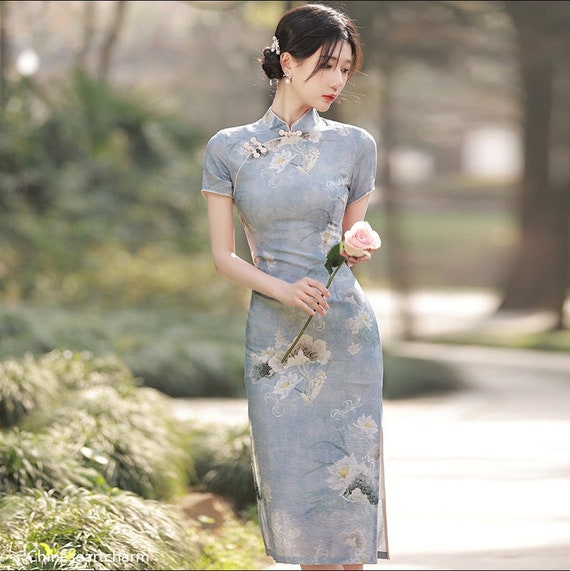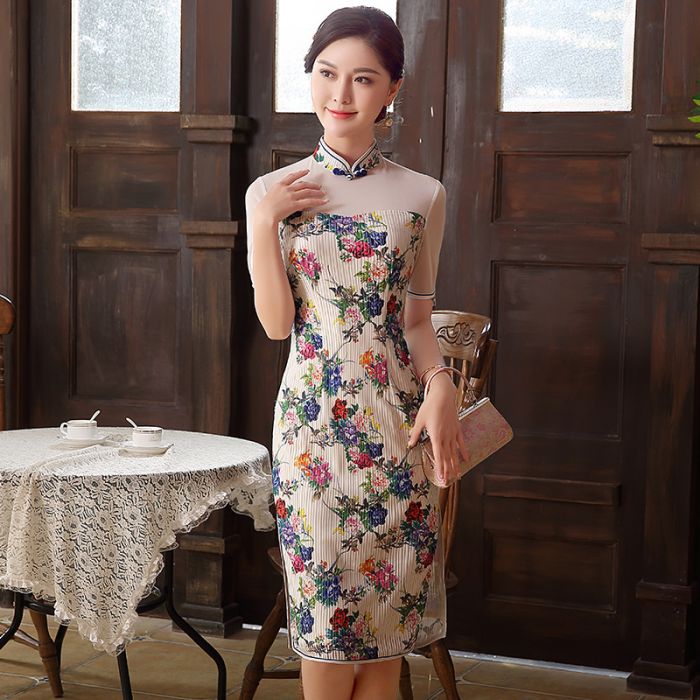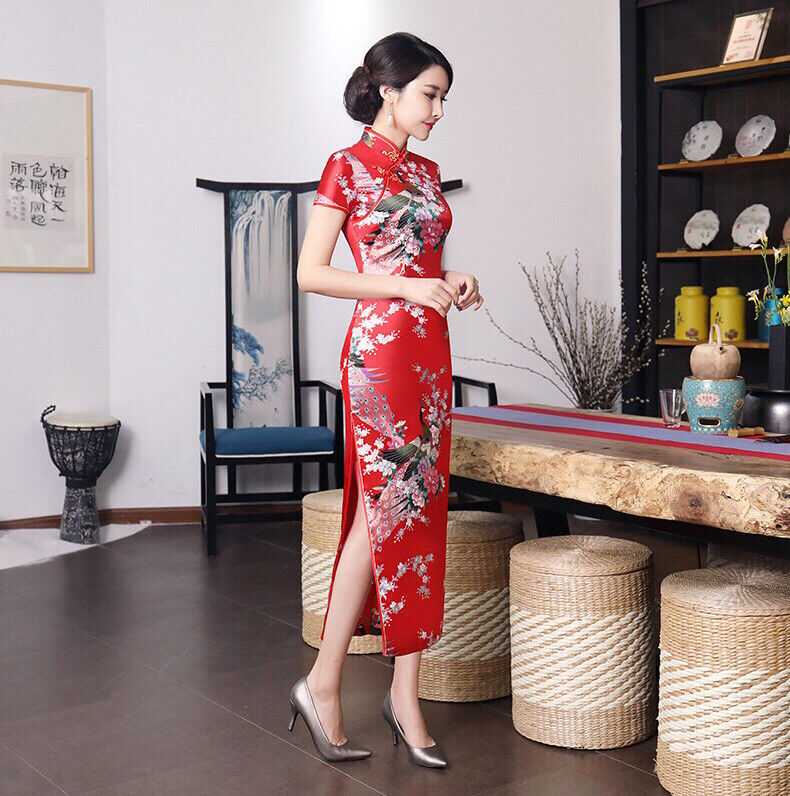Introduction: The Timeless Charm of Cheongsam
The cheongsam, also known as qipao, is a traditional Chinese dress known for its beauty and elegance. Originating from the 1920s in Shanghai, it has evolved into a symbol of Chinese feminine grace. The cheongsam combines Chinese cultural heritage with modern fashion sensibilities, making it a unique and iconic ensemble. Wearing a cheongsam is not merely about donning a piece of traditional clothing—it’s about embracing an entire cultural legacy that speaks to both the past and the future of Chinese aesthetics.
Historical Evolution of the Cheongsam
From Qing Dynasty to Modern Chic
The cheongsam dress has undergone significant evolution from its original Qing Dynasty form, which was loose and baggy. To the modern figure-hugging silhouette it is known for today. In the early 20th century, Shanghai became the fashion hub of China and the epicenter for the cheongsam’s transformation. Influential women of the era reimagined the dress to reflect the then-modern ideals of femininity and elegance. By the 1920s and 1930s, the cheongsam had become a fashionable choice for many Chinese women, signifying social status and modernity.

The Cheongsam in Global Fashion
As an emblem of Chinese culture, the cheongsam has transcended its origins and entered the world stage. It captured the West’s fascination in the early to mid-20th century, and since then, it has frequently appeared in international events and red carpets, worn by celebrities and political figures alike. Occasions, such as Chinese New Year, weddings, and formal gatherings, often see the cheongsam celebrated as an attire of choice for its elegance and cultural significance. In global fashion, designers periodically incorporate elements of the cheongsam in their collections, acknowledging its timeless appeal.
The Cheongsam Today: Revival and Innovation
In recent times, there’s been a revival of interest in traditional cultures and heritage fashion, with the cheongsam at the forefront in China and abroad. Contemporary designers are innovating the classic design, integrating new fabrics, patterns, and styles while maintaining the dress’s distinctive features. Today’s cheongsams can range from high-end fashion pieces that showcase intricate embroidery and luxurious materials to more casual interpretations crafted from modern, comfortable textiles suitable for everyday wear.
The Artistry Behind the Cheongsam Dress
Signature Features of the Cheongsam
The cheongsam is characterized by its distinctive mandarin collar, side slits, and a form-fitting cut which creates an elongated silhouette. The traditional dress fastens with knotted buttons or ‘frog closures’ that add an additional element of intricacy. Cheongsams can be short-sleeved, sleeveless, or long-sleeved and often feature beautiful patterns or embellishments such as embroider flowers, birds, dragons. Or geometric shapes that reflect the richness of Chinese culture.

Choosing Fabrics and Textiles
High-quality cheongsams are crafted from luxurious fabrics such as silk, satin, brocade, and velvet, chosen for their luster and fine texture. Silk is particularly valued for its lightweight and smooth properties, making it comfortable to wear while offering a sophisticated sheen. Brocade and velvet, often chosen for more opulent designs. Feature raised patterns that give the garment a sense of depth and luxury. Some modern dress employ cotton and linen blends, providing breathability and ease for daily wear without sacrificing the dress’s traditional elegance.
The Importance of Tailoring and Fit
The beauty of a cheongsam largely lies in how well it fits the wearer’s body, accentuating the natural curves without restricting movement. Expert tailoring is crucial – a perfectly tailored cheongsam should contour comfortably to the shape of the body while allowing enough ease for the wearer to move freely. Many people opt for custom-made cheongsams for this reason, ensuring that the length of the dress, the height of the slits. And the fit around the chest, waist, and hips are all personalized to their individual measurements.
Wearing a Cheongsam Dress
Appropriate Occasions for the Cheongsam
The versatility of the cheongsam makes it suitable for a wide range of events, from formal celebrations to casual outings. A luxurious, embroidered cheongsam is a stellar choice for weddings, banquets, and official functions, embodying poise and tradition. For less formal occasions like family gatherings or festivals, a simpler cotton or linen qipao offers comfort and style. The dress has become an increasingly popular option for everyday fashion among those looking to bring traditional elegance to their modern wardrobe.

Accessories to Complement the Cheongsam
Accessorizing a cheongsam requires a balance of subtlety and complementarity. Traditional Chinese jewelry like jade bangles, ornate hairpins, or elegant earrings can enhance the dress’s cultural roots. For a more contemporary look, minimalist and
modern accessories like a watch, simple necklace, or clutch can add a touch of sophistication. Shoes are integral too, with high heels often chosen to heighten the elegance of the silhouette—though for a day-to-day outfit, stylish flats or even sleek sneakers can bring a casual twist to the dress. When choosing accessories, the key is to respect the cheongsam’s clean lines and not overwhelm its distinctiveness.
Styling and Personalization
Incorporating personal style into wearing a cheongsam is both a celebration of individuality and heritage. For a bold statement, some choose to pair the dress with a contrasting leather jacket or a denim vest, blending traditional and modern elements. Others may opt for a shawl or scarf that complements the colors and patterns of the cheongsam. Especially in cooler weather. Hairstyles can range from classic updos that reveal the elegance of the collar to free-flowing styles that offer a more relaxed appearance. When personalizing the cheongsam, the trick lies in harmonizing personal style with the dignified grace of the dress.

Preserving and Caring for Cheongsam Dresses
Proper Maintenance Techniques
The delicate fabrics of cheongsams require careful maintenance to preserve their beauty and extend their lifespan. Silk cheongsams, for instance, should be dry-cleaned or hand-wash with a mild detergent and cold water to prevent damaging the fibers. It’s also important to avoid wringing or twisting the fabric. As this can cause deformation. After washing, the dress should be air-dried away from direct sunlight, which can fade colors and weaken fabric. Brocade and velvet cheongsams may have more specific cleaning requirements. So always check the garment label or consult with a professional cleaner.

Mending and Upkeep
With time and wear, cheongsams may require mending to maintain their pristine condition. This might include repairing loose threads or replacing missing buttons. When alterations are necessary, it is best to seek out a tailor experienced in working with traditional garments to ensure that repairs are done with accuracy and care that matches the original craftsmanship. Proper upkeep will guarantee that the cheongsam remains a treasured piece in one’s wardrobe for years to come. Ready for special occasions or becoming a fashionable heirloom passed down through generations.
